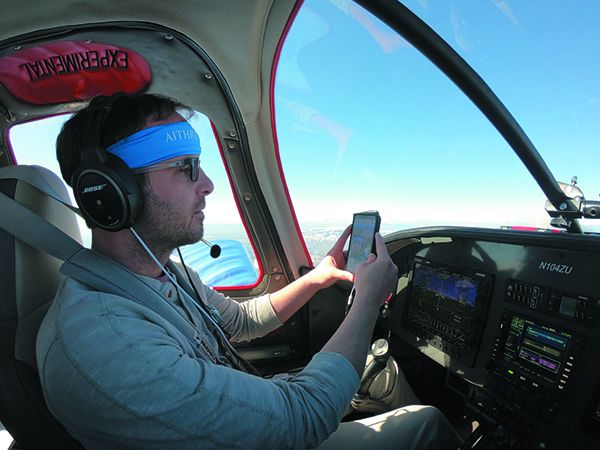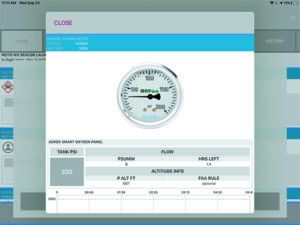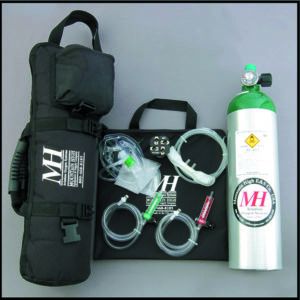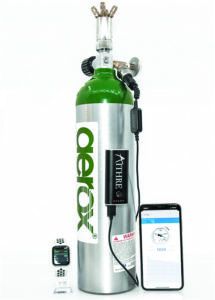
We pilots must be nuts. We willingly strap ourselves into frangible vehicles with cabins smaller than occupied by a heinous criminal in solitary confinement and then climb to altitudes where our brains are deprived of oxygen to the extent performance of the tasks essential to a safe return to the planet is put at risk.
And then we do it again. And again.
One completely unsupported hypothesis behind such seemingly foolish repetition is that because a symptom of hypoxia—we’ll talk about that ugly, dangerous condition in a moment—is euphoria, pilots fly because they want to experience aviation’s version of rapture of the deep.
While science has not determined the reasons that certain humans feel the ongoing need to rise above the ground in aeronautical vehicles, the science is clear that using supplemental oxygen increases their chances of doing it safely.
LUNG LIMITS
When air molecules get progressively farther apart, our lungs are increasingly less capable of mixing oxygen from the air with hemoglobin to oxygenate the bloodstream. As our blood’s oxygen saturation level drops very bad things happen to our bodies: Vision deteriorates, mental and physical functioning goes down the slot and our ability to recognize that our performance has radically degraded is also radically degraded. Stress and fatigue exacerbate hypoxia plus, we become subject to it at lower altitudes as we age.
The solution to the problem is supplemental oxygen. We’re going to go into depth on supplemental oxygen systems, what’s in a system, what’s on the market and look at prices.
THE GAS
We’ll start with the supplemental gas we need—where does the oxygen come from? All oxygen produced in the U.S. is made through a process called liquefaction. It’s a process that, simplified, involves compressing and cooling air (yes, when you compress a gas it heats up, so cooling it isn’t simple) to such an extreme state that it becomes a liquid. The component gases are then boiled off, leaving only nearly pure liquid oxygen.
Oxygen is oxygen—it’s an element, number eight on the periodic table. Ever since liquefaction became the only process for producing it there has been no difference between industrial, medical and aviation oxygen. None. That means that the least expensive place to buy oxygen is usually your local welding shop. Interestingly, some states require that you have a prescription to buy oxygen from a medical supply facility.
Oxygen used for aviation is not some super-duper drier form of the gas. Nevertheless, apparently due to the age of the FARs, oxygen used in Part 135 operations must be “aviator’s breathing oxygen” and meet a supply chain testing requirement. There is no such requirement for Part 91 operations.

How much oxygen is left? That’s what you might find yourself asking on a cross-country trip if you don’t have easy access to the tank. It’s why I like the idea of equipping the tank with a wireless Bluetooth-enabled flow transducer so you can easily view the stats on a smartphone app, which is just what Ketchum, Idaho-based Airthre Aviation has done with its $195 Altus Meso.
This innovative approach combines medical-grade tank hardware with an easy-to-use app that’s part of the company’s smart ecosystem of wearable oximeters and CO detectors. The Altus Meso (powered by a USB power bank) attaches directly to a portable oxygen tank, measuring the oxygen pressure in the tank as we’ll as the flow rate, which calculates the time remaining in the tank. Aithre and Aerox Aviation recently announced an exclusive partnership, where Aerox tanks can be purchased with Meso pre-installed, a $46 savings over buying it separately. The Meso device attaches to the tank and fits into the Aerox case, which includes a pocket for storing the power vault. I’ve been flying with it in my Rockwell Commander and found the setup to be simple to install. It requires a wrench, supplied oxygen-grade thread tape and Simple Green cleaner (no bubbles, no troubles).
The Connect app automatically connects to the Meso when you launch it. The homepage provides a summary of the data from the connected devices right at the top (CO PPM, O2 PSI, SpO2 %). The app is we’ll laid out and you can purchase (in-app) additional features, like the airport weather assistant. The onscreen O2 tank tab has a an image of the Aerox gauge, as we’ll as digital readings for the tank’s PSI, PSI per-minute flow, hours left, pressure altitude and a review of the FAA rules (based on your pressure altitude). The bottom of the screen has a graph showing the PSI time lapse. The app is pretty intuitive to use. However, I suggest launching the app before you plug the Altus Meso into the USB power vault to ensure that pairing occurs. Flying with the app was easier than having to reach around the seats to get a look at the gauge on the tank, and we think it’s worth the investment.
Aithre is working on an Android version of the Connect app, but there’s no firm release date. We’ll keep tabs on it.
—Phil Lightstone
HAULING IT AROUND
While some general aviation airplanes contain oxygen systems installed at the factory, most of us will need a portable system to supply the gas. Fortunately, it’s easy to carry a four-place oxygen system in a bag. The system consists of an oxygen bottle (tank), a regulator that reduces the pressure of the compressed oxygen from the 2100 PSI range to a range that can be accommodated by a flow control device and then tubing and either an oxygen mask, standard cannula or a type of oxygen-conserving cannula—most commonly one called an Oxymizer.
BOTTLES
The industry refers to oxygen tanks as bottles—and they are available in a wide range of sizes, capacities, shapes and weights. For this article we looked at 20- to 24-cubic-foot bottles. They can carry enough oxygen for an extended round trip without refilling and are small enough that a pilot can get one in or out of the airplane without risking a trip to the ER. For reference, a bottle that size should provide at least six hours of oxygen for one person at 15,000 feet.
The most common material used for general aviation oxygen bottles is aluminum (steel is long gone). Aluminum bottles have no published life limit; however, they must be hydrostatically tested every five years.
Our local shop sends their bottles to C & L Aero (www.c-l-aero.com) in Redding, California, for testing. It’s truly a mom and pop organization that has been in business for 20 years. We talked with both principals, Linda and Jeff Connolly, who told us that a hydrostatic test runs about $100. It involves de-valving the bottle, doing the pressure test for leaks, draining and re-valving it. Turnaround time is two to three days. The tanks are shipped empty—if they contain oxygen under pressure they are hazmat.
The other materials used for bottles are carbon fiber and Kevlar. Both are lighter than aluminum; however, for the relatively small bottles used for portable systems the weight difference is not great while the price difference is substantial. Worse, they have a 15-year life limit and also must be hydrostatically tested every three years. Jeff Connolly told us that he rarely sees anything other than aluminum tanks come in for testing from portable systems.
REGULATORS, FLOW
Our market survey showed that regulators vary by number of outlets and ability to adjust oxygen flow for the number of users on the system.
Oxygen flow is either continuous or adjustable. A continuous flow regulator sets a constant flow of oxygen that is good up to about FL250, and more than enough at lower altitudes, essentially wasting oxygen.
An altitude adjustable system has a control on the regulator or flow meter for the user to set the flow that is appropriate for the altitude. They are usually clear plastic or acrylic (better) tubes with unmetered oxygen from the regulator entering at one end and a metered flow to the cannula or mask coming out of the other. The flow is adjusted using a thumbscrew needle valve that suspends a ball in the plastic column of the flow meter corresponding to a scale calibrated in altitude on the side of the column.
Another form of adjustable flow system is pulse-demand—the system provides a puff of oxygen when the user inhales. It substantially reduces the amount of oxygen wasted in continuous flow or altitude adjustable systems.
We recommend that no matter what flow method is used, there should be an indicator in each user’s line to show if oxygen is flowing to the user. Most of the indicators we’ve observed use green to show flow and red to show no flow.
Based on experience, we strongly suggest that each user check the flow meter periodically as we have had oxygen lines get pinched or kinked—stopping the flow—as people move about in the cabin.
We also recommend that each user have access to a pulse oximeter and use it at least every half-hour. No matter how the flow is set up, what matters is whether the user is getting adequate blood oxygenation.
CANNULA AND MASKS

We’ve found that most pilots and passengers prefer to use an oxygen cannula rather than a mask. Cannula are inexpensive—less than $2 each on Amazon. They are worn with the splitter under your chin, the two tubes behind your ears and the cannula tucked into your nose, with the tab on the side opposite the nasal tubes pointing down. The slider is moved upward toward your chin to tighten everything, but not so much that it is uncomfortable.
Some pilots insert the nasal tubes and run the tubes on either side of their head and tighten the splitter behind their head. We wonder about the potential for choking if something goes wrong.

A conserving (Oxymizer) cannula rebreathes a portion of the oxygen it receives via a bladder. For about $40 each, they cut oxygen use by at least half.
Street prices for oxygen masks start at $10. For an oxygen mask with a microphone, plan on spending close to $500.
SYSTEMS
As we’ve been tracking portable oxygen systems we’ve noted that the business has remained highly competitive. We’ve seen prices stay nearly the same or even drop slightly over the last five years.
One longtime supplier has dropped out of the business, but we didn’t see prices go up as a result. We’ve also noted that system options offered vary widely and that components from one supplier may not be compatible with those from another.
We strongly recommend that if you intend to buy a system, that you call and talk with the provider to make sure you understand what is offered and what it will and won’t do. We have consistently found that the providers are willing to patiently talk oxygen for as long as you are and will help ensure that you find and tailor a system that fits the type of flying you do.

MOUNTAIN HIGH
Long considered to provide some of the most sophisticated systems on the market—as we’ll as offering the most options—Mountain High’s website (www.mhoxygen.com) goes into what we consider to be an excellent, step-by-step tutorial in aircraft oxygen systems.
The regulator offered has four ports with snap-in connectors that all face the same direction rather than radially in all directions—a plus, we think, in a cramped cabin.
Mountain High offers a pulse demand oxygen system—referred to as Electronic Delivery System (EDS)— that it says will plug into almost all portable oxygen systems. It replaces the flow meter and reduces wasted oxygen by sending a measured pulse of oxygen when the user inhales—a reported 30 percent over a minimizing cannula. Refer to the website to determine what cannula can be used with EDS.
Mountain High offers two different regulators: the MH-3 for use with a cannula up to 18,000 feet and the MH-4, which has two scales so it can be used with an Oxymizer cannula up to 18,000 feet or a standard cannula or a mask up to 25,000 feet. Each is priced at $65 and Mountain High says they can be used on any portable oxygen system.
The company also offers a cannula that attaches to a headset. Some years ago, we tested its $99 E-Z Breathe II Boom Cannula and found it more comfortable than a standard cannula and slightly easier to use. We recommend it for someone who uses oxygen frequently.
AEROX
Aerox (www.aerox.com) includes individual flow meters in all of its systems, including its most basic two-place unit (not all companies do so). It offers a large variety of oxygen bottle sizes. The regulators are equipped with push-pull connectors that simplify plugging in or removing users and straightening out tangled oxygen tubes.
Aerox recently began offering the sophisticated Aithre Altus Meso monitor that attaches to the oxygen bottle. It transmits pressure, flow rate and time remaining to an iOS device—something we consider valuable when the bottle has to be stashed where it can’t easily be seen. The monitor will also connect to a $99 Illyrian Smart Oximeter worn by the user and transmit the user’s blood oxygenation level to the iOS device as well.
In the past we have recommended that Aerox make its website more user-friendly and provide more details on its system, and the new management has been working on it.
DELTA AIR-KING, SKYOX
Delta Air-King (www.deltaoxygensystems.com) offered the lowest priced basic two-place system. It has no flow meters but it includes both cannulas and masks. Upgrading the basic systems isn’t horribly expensive and there are a lot of options, including an oxygen headset—although it is just that, a headset that supports a cannula or mask, not earphones or a mic.
Delta Air-King’s website is relatively easy to navigate, although we found at least one inconsistency in pricing and we note that orders must be made by phone. Delta Air-King offers a low price guarantee and lifetime warranties. SkyOx (www.skyox.com) keeps the cost of its systems low by not providing individual flow meters for each user; a single flow valve adjusts the flow of oxygen so that it is the same for each user. Each system comes with Oxymizer cannulas and one mask.
PRECISE FLIGHT
Precise Flight (www.preciseflight.com) developed a mechanical (no batteries needed) pulse demand oxygen unit, the X3 Demand Conserver. For $1095 for two users, Precise Flight claims it will increase oxygen duration by at least 300 percent. Precise Flight’s oxygen equipment carries a lifetime warranty.
Precise Flight is the only company that we found that provides the same number of masks as it does cannulas with its portable systems.
CONCLUSION
The science on a pilot’s need for oxygen even below 10,000 feet is clear—the numbers on the altimeter matter less than the numbers on the pulse oximeter. That makes a portable oxygen system a wise investment, in our opinion.
From a pilot’s point of view, our survey of the market had two positive results: There is no shortage of portable oxygen systems available to be tailored to specific needs and the market is so competitive that prices haven’t been following aviation’s pattern of rapid increases.
If we had to pick, Aerox and Mountain High would be top choices. We like the Aerox paired with Aithre’s Altus Meso smart gauge, especially if the tank is stored out of reach. Paired with Aithre’s full-time pulse oximeter it’s the best biometrical backstop we’ve seen to date.

